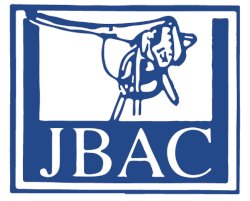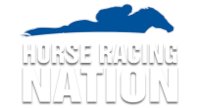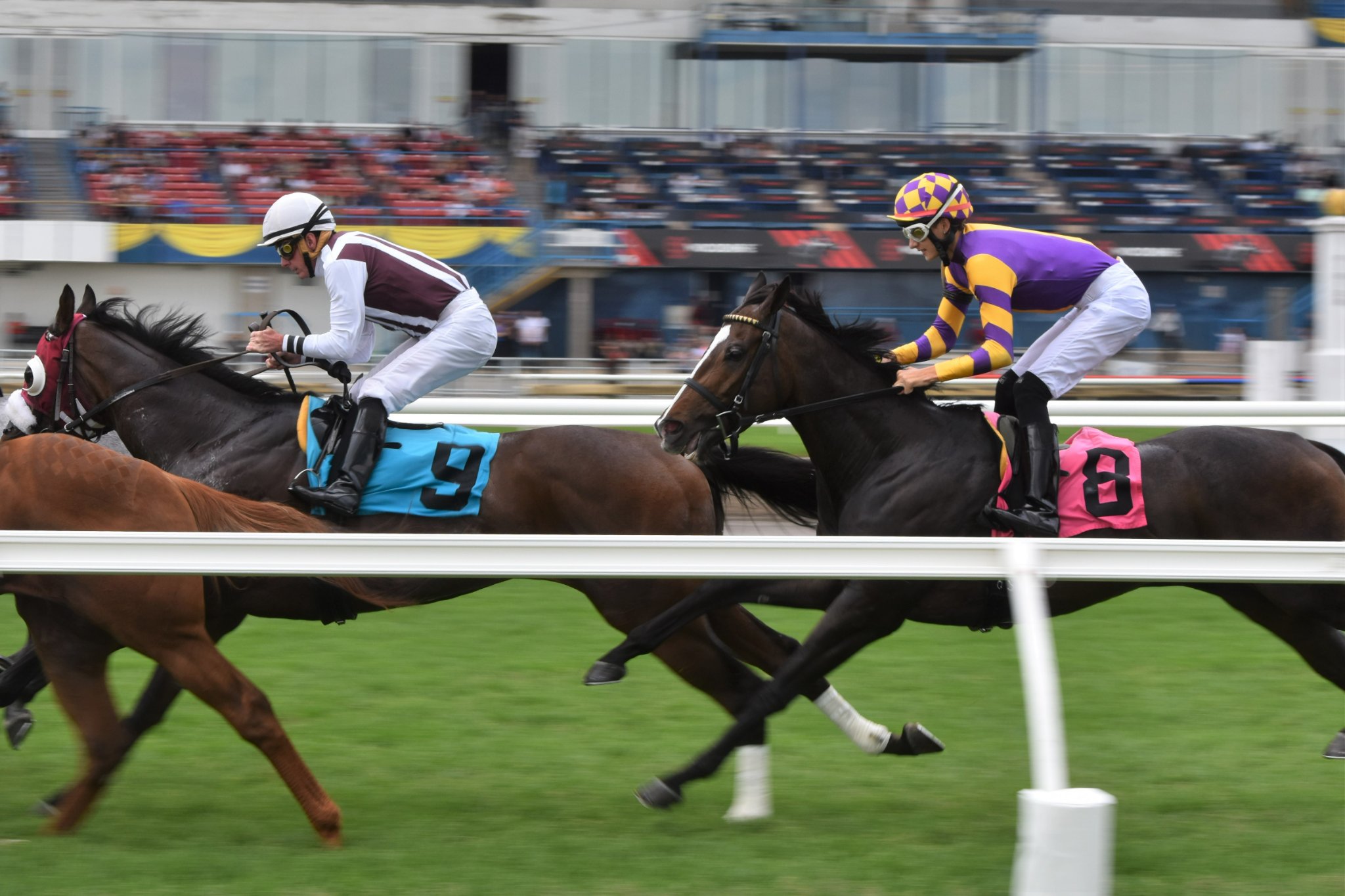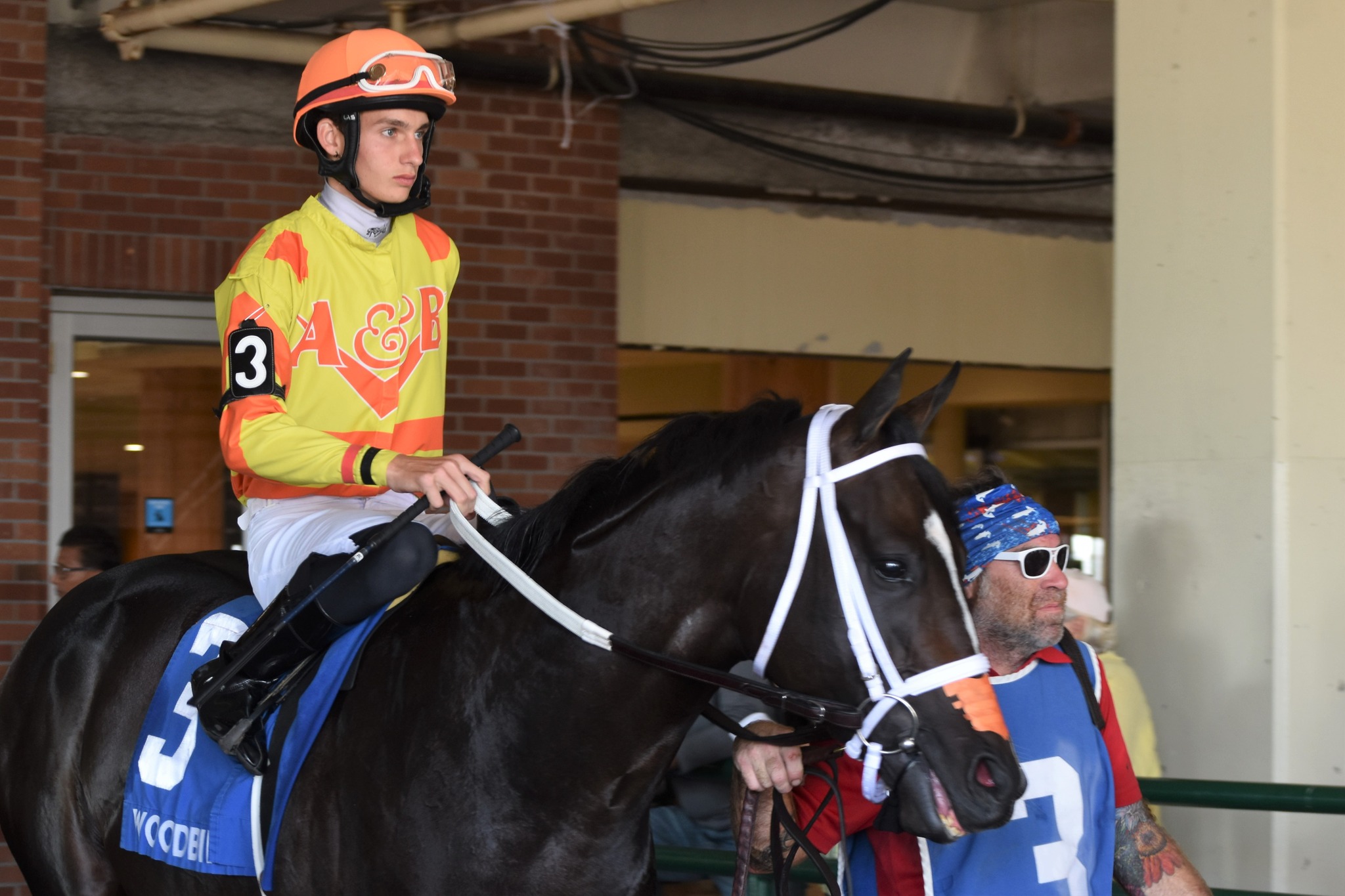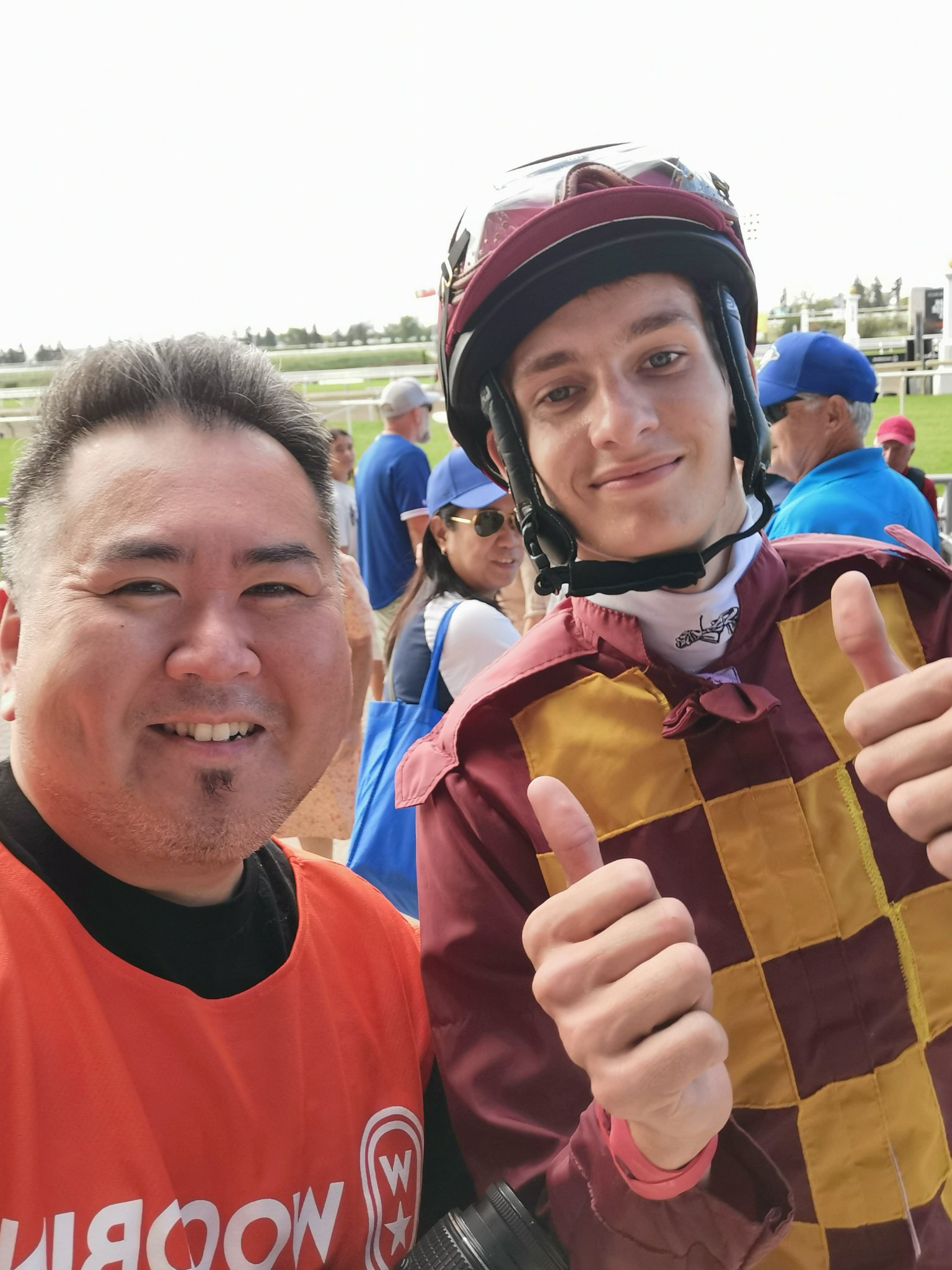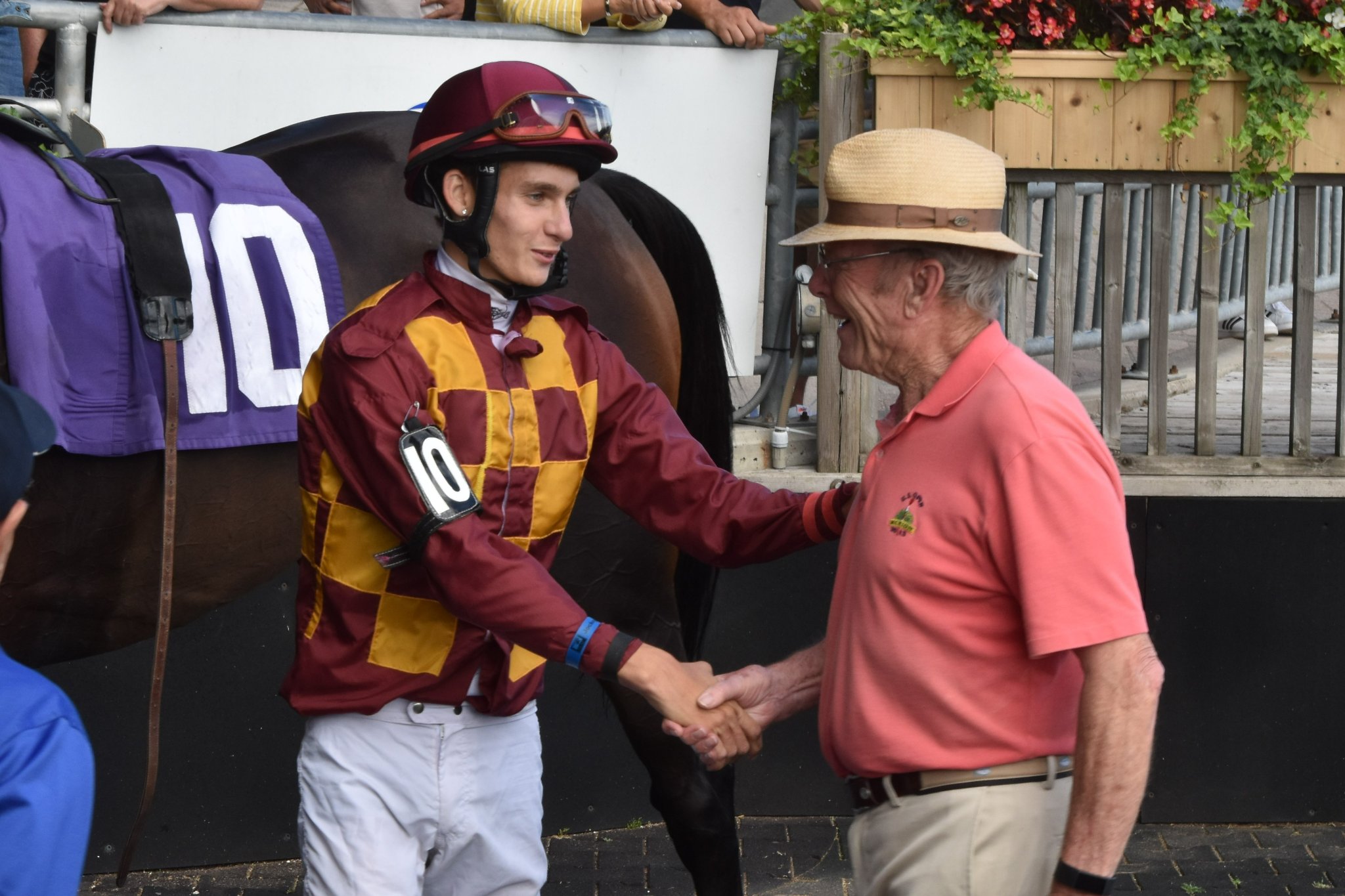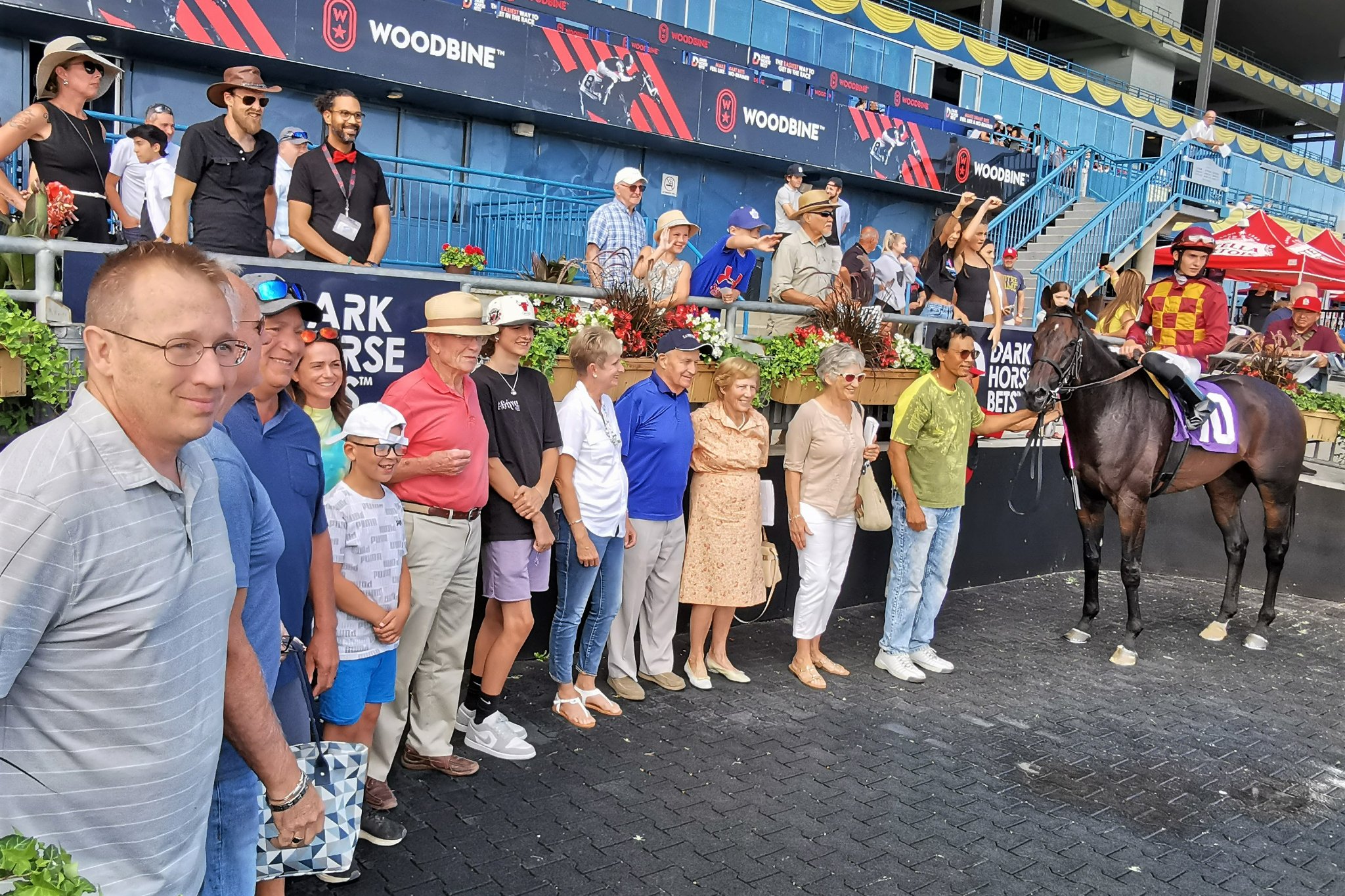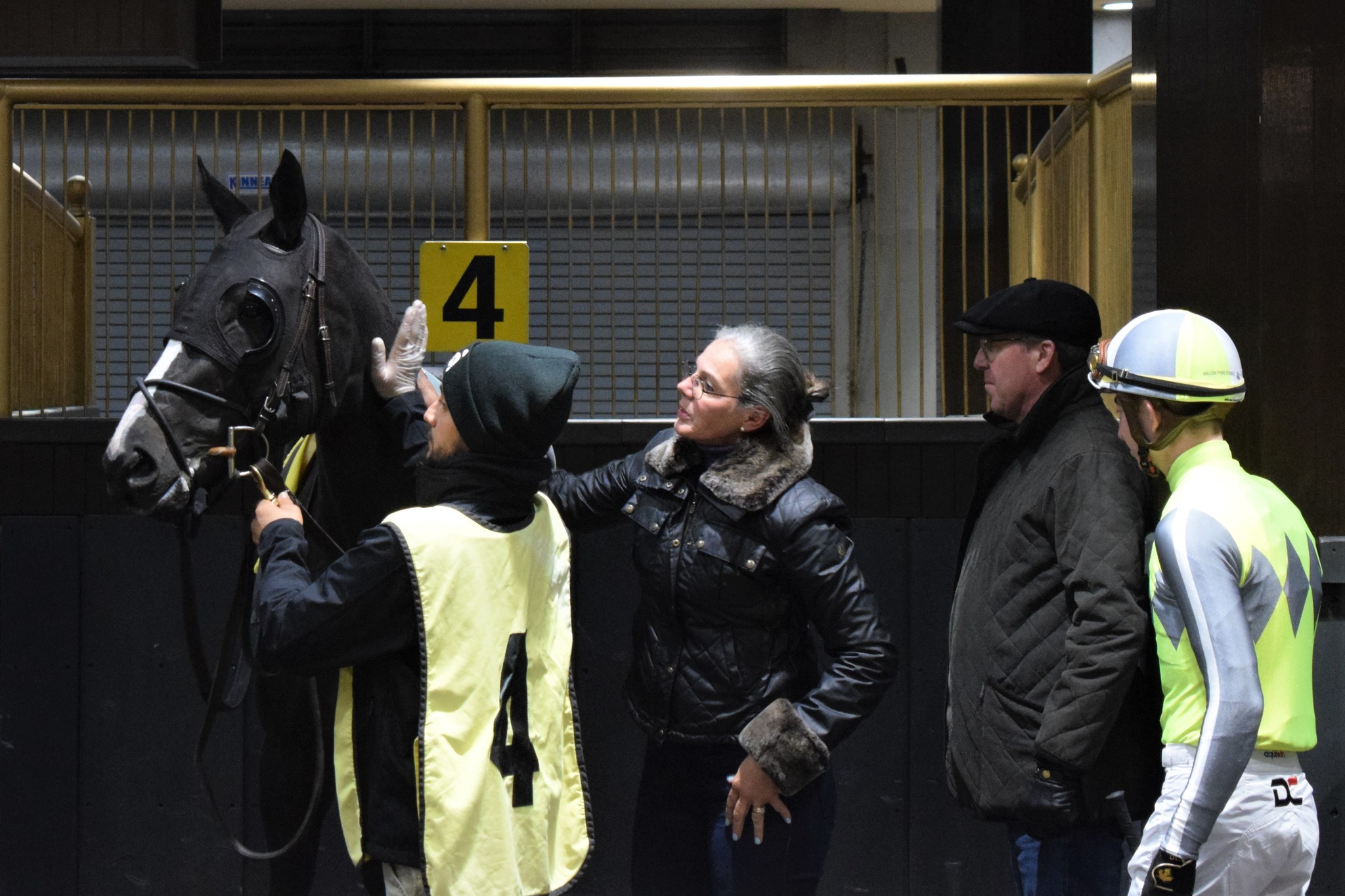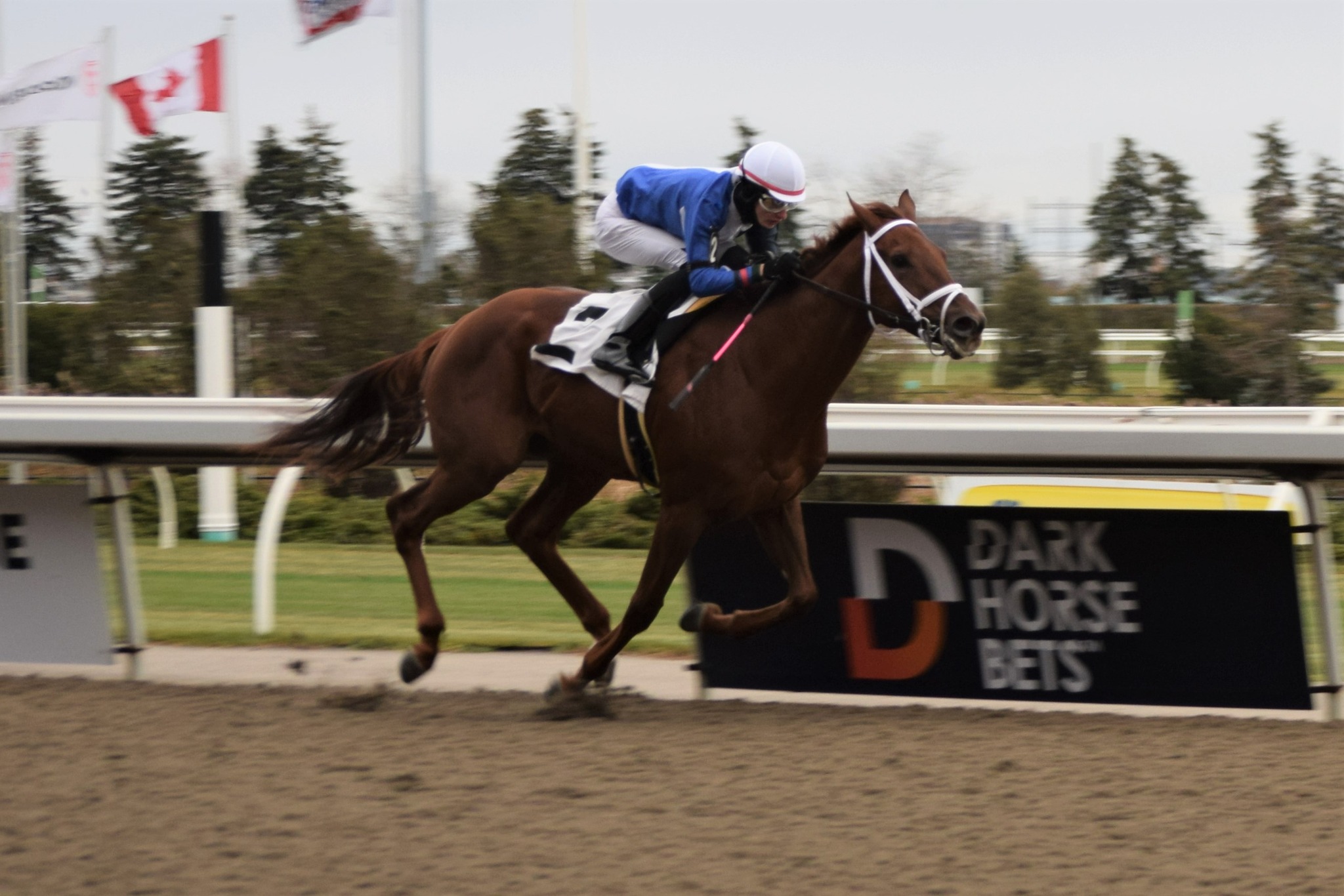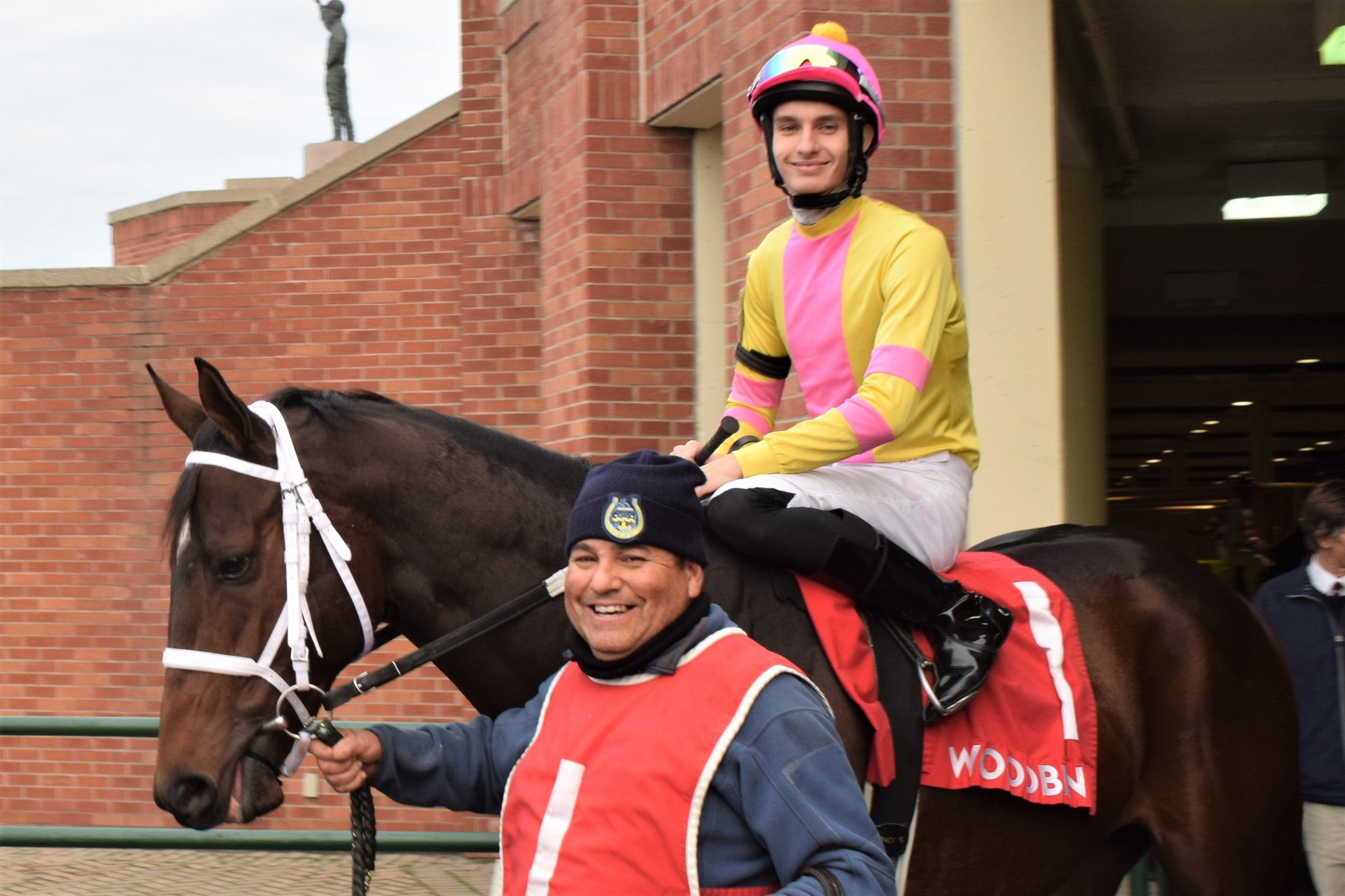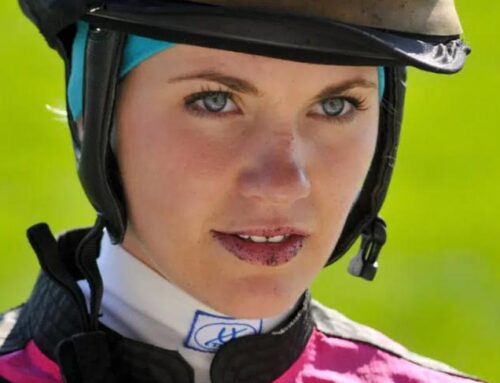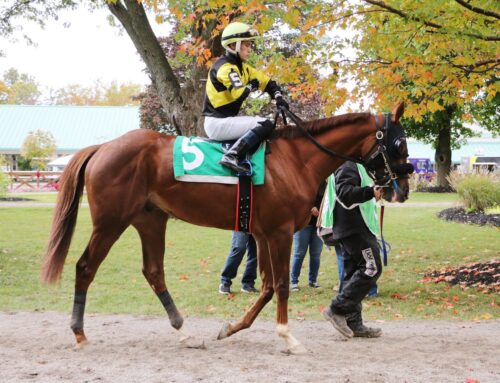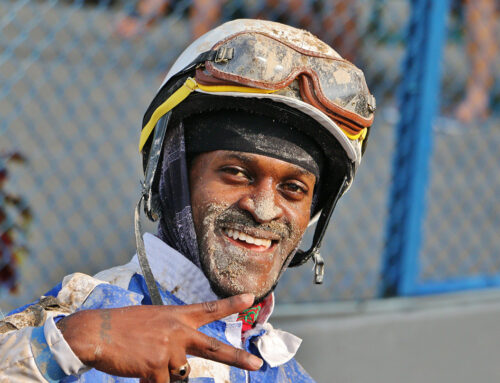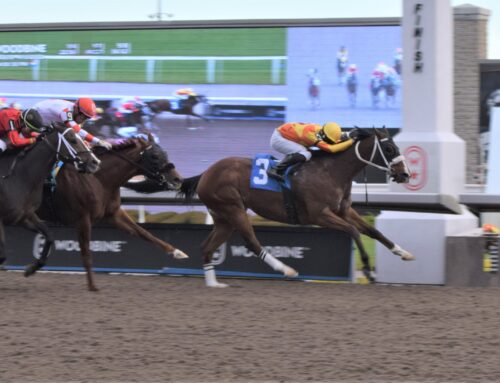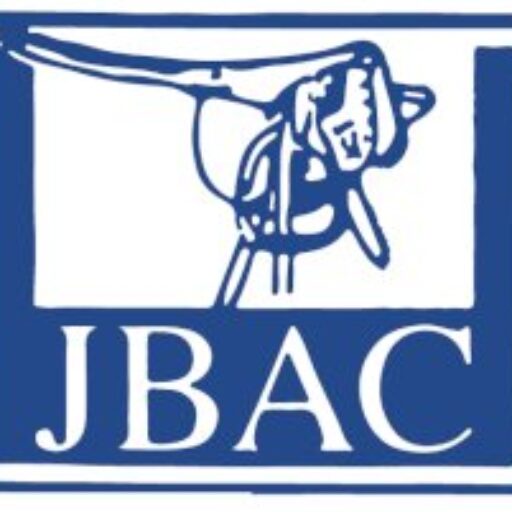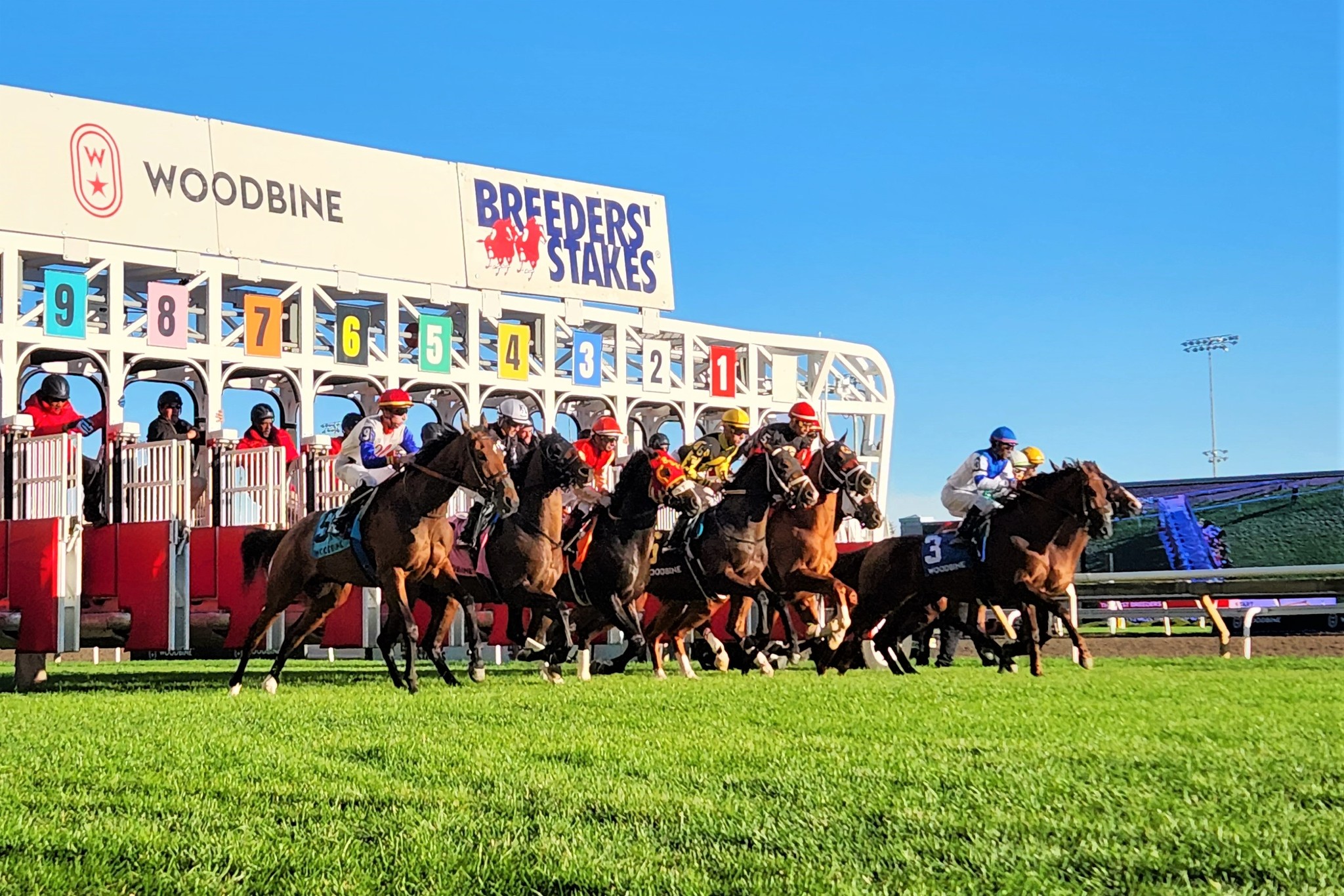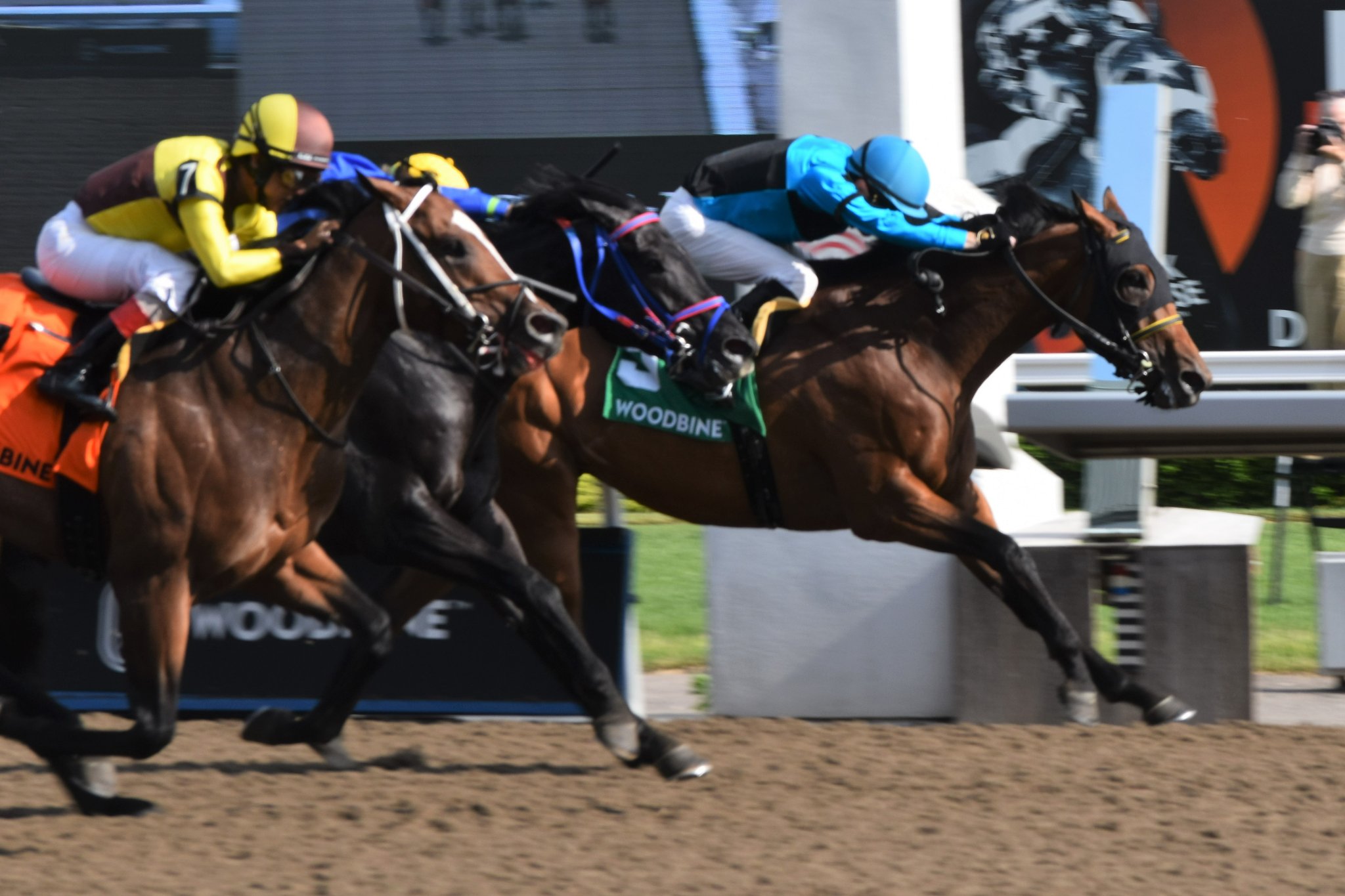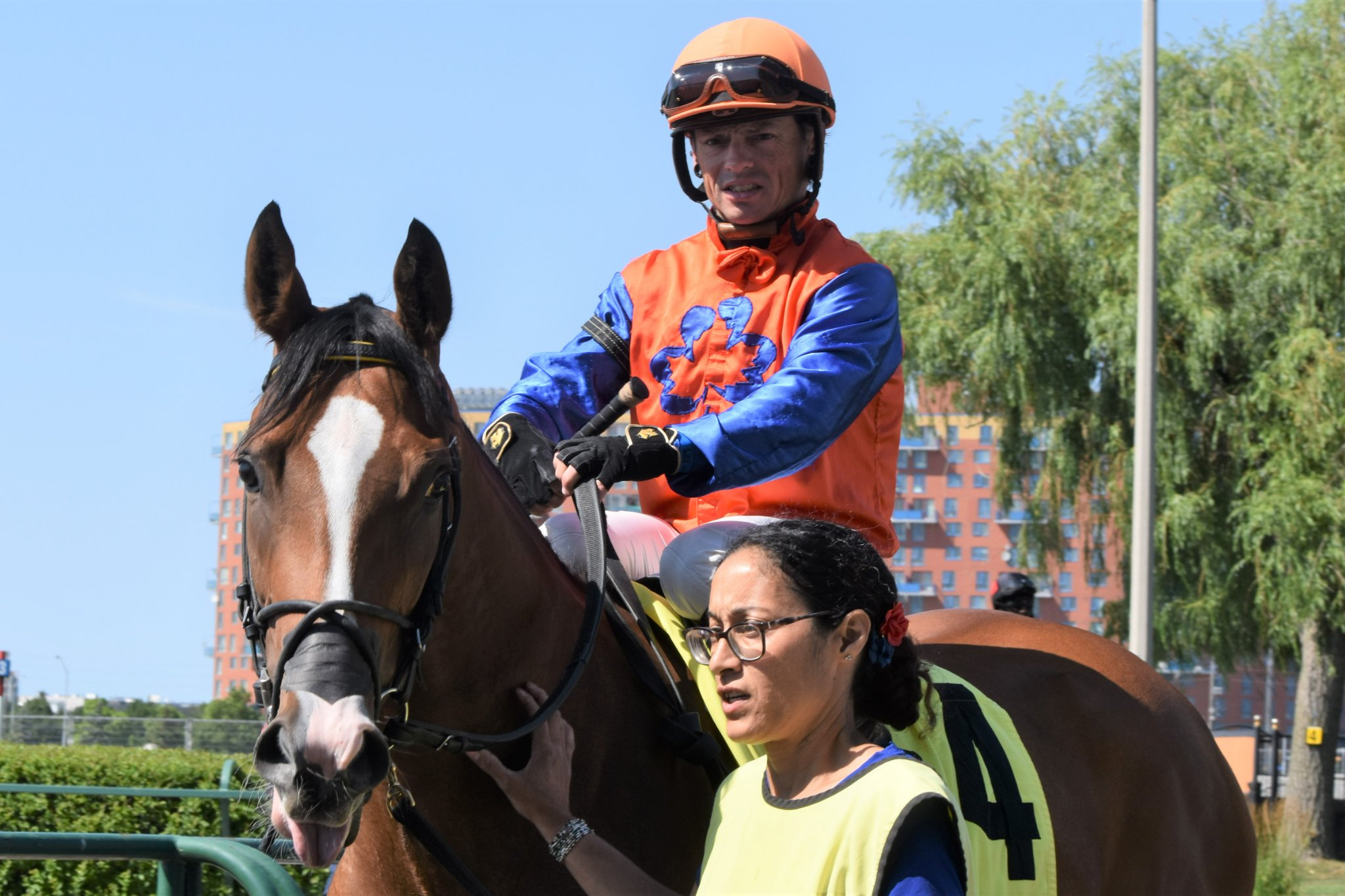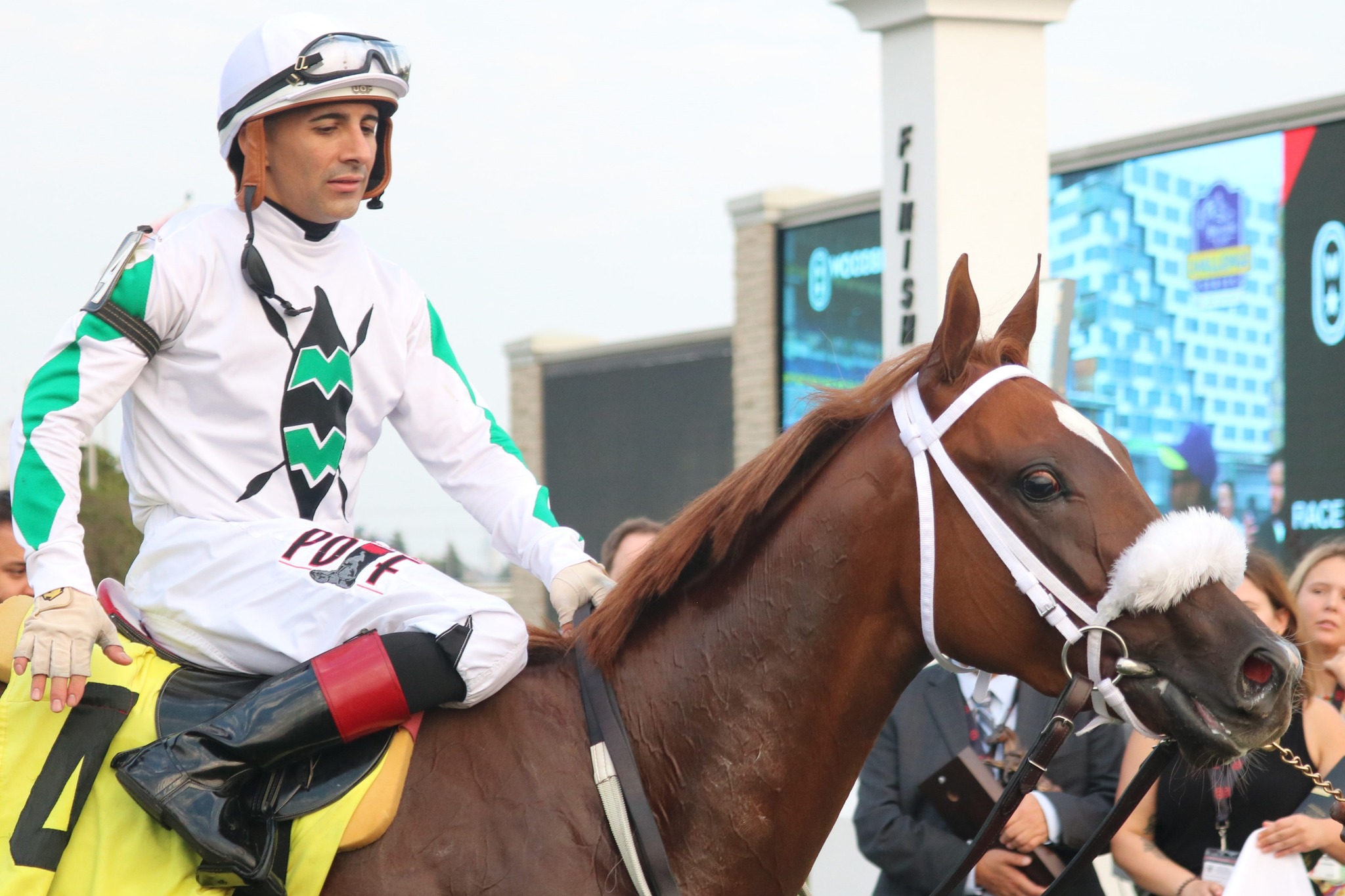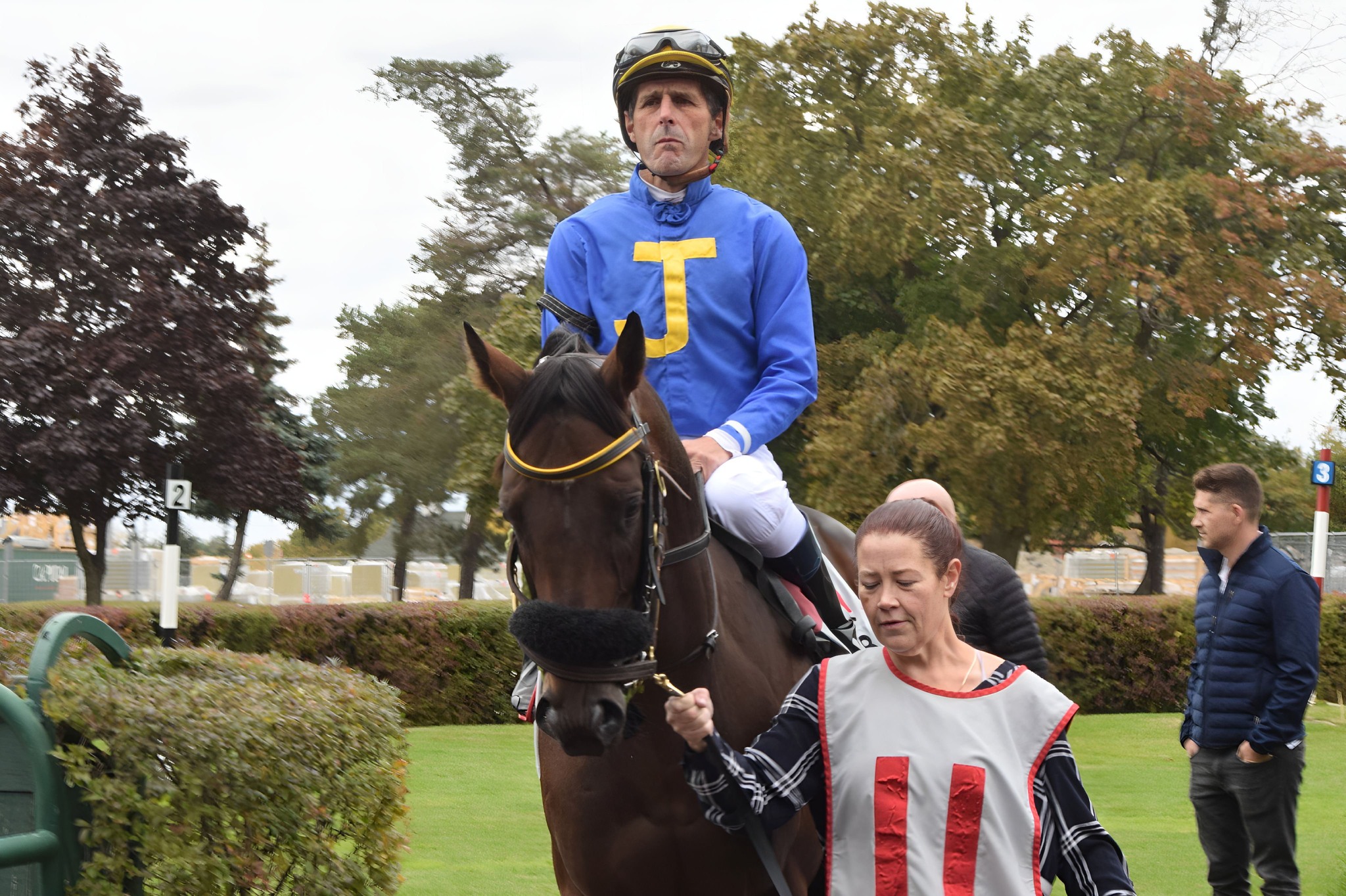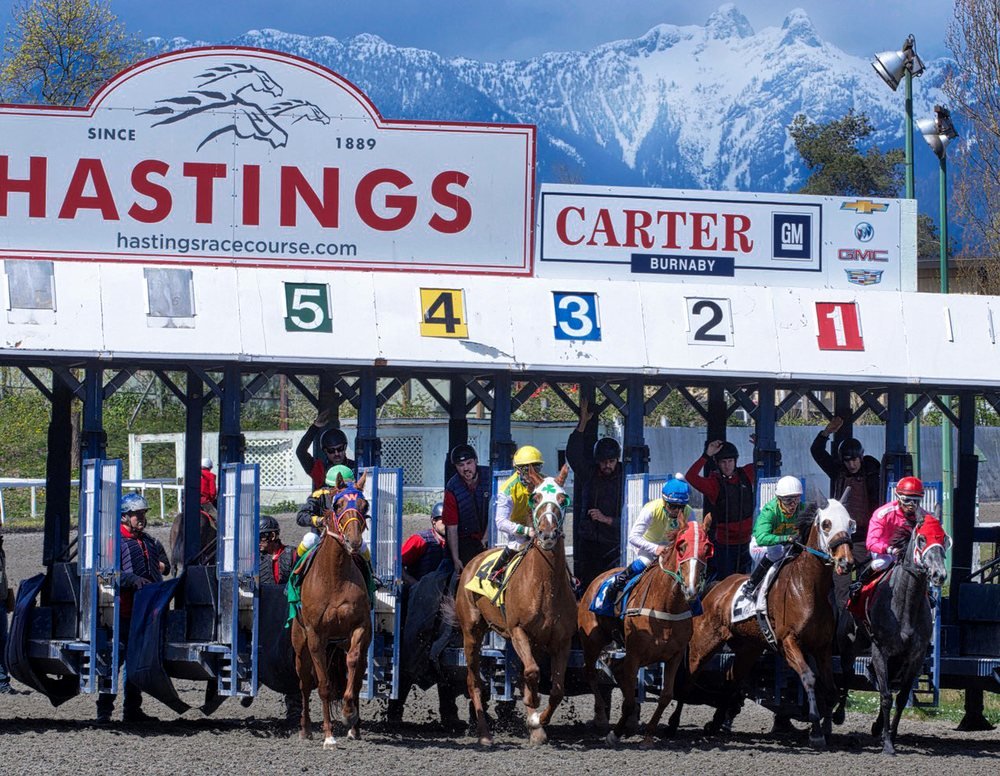Slade Jones
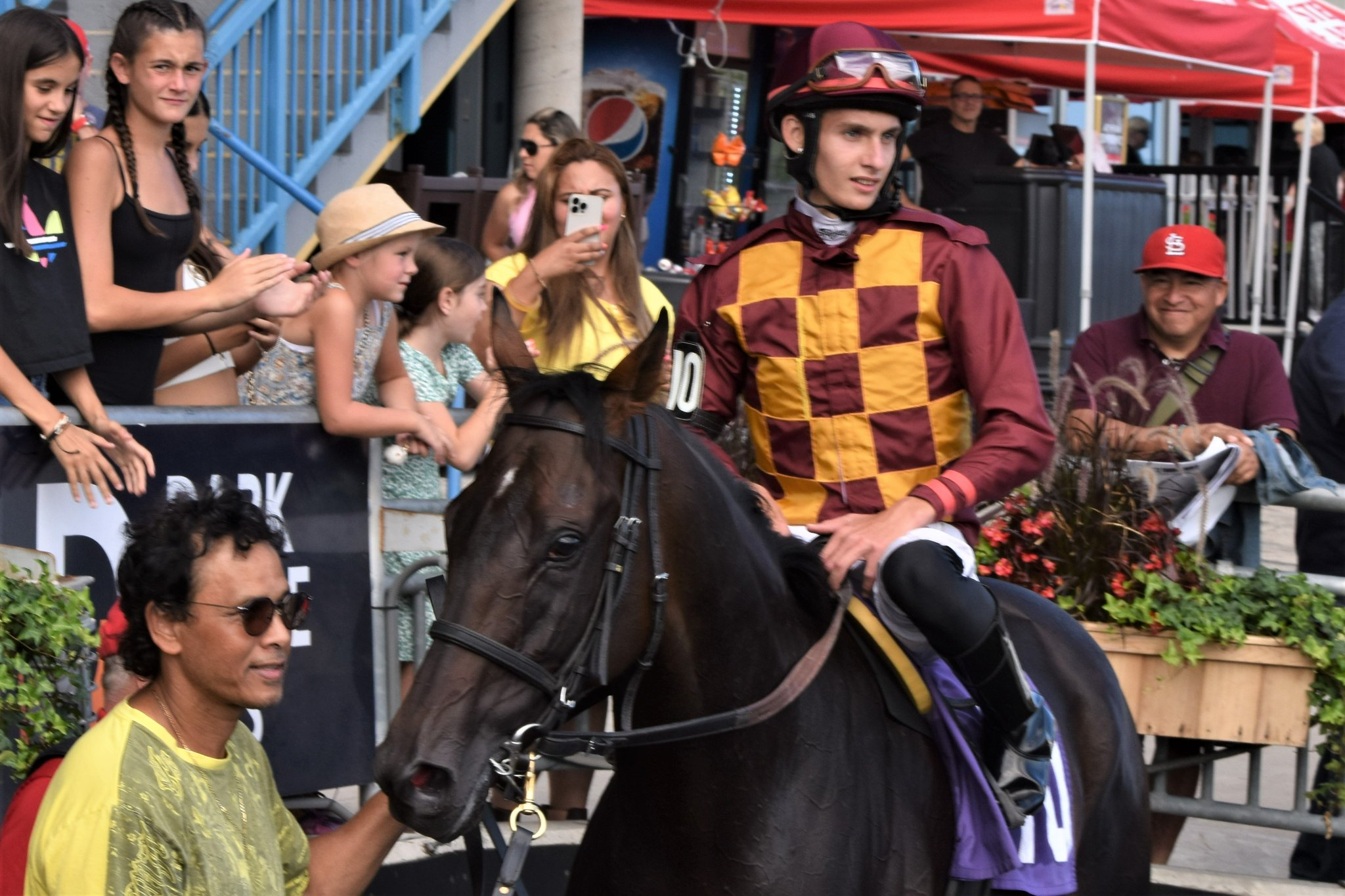
Slade Jones just days after receiving the Sovereign Award for Canada’s Outstanding Apprentice Jockey for 2022, 16-year-old Slade Jones has returned to his home in Barbados and will not ride this year. According to his agent Tom Patton, Jones, who is nearly six feet tall, was having trouble maintaining his preferred riding weight last fall, and the issue has persisted. Read more at Canadian Thoroughbred – By Jennifer Morrison | April 17, 2023
Slade Jones is the newest jockey calling Woodbine home these days. At 16, Jones is also the youngest rider in the colony since the likes of Hall of Famer Mickey Walls.
“I would just like to win races, do well, have a safe year, and for everything to run smooth.”
Clear-cut words were spoken by none other than Slade Jones.
By: Woodbine Communications | by Hayley Morrison | June 15th, 2022,
While plenty of media buzz surrounds Jones’ arrival, the teenager is taking everything in stride. A stride that isn’t easy to maintain and one that many people aren’t privy to truly understanding. However, it is something that his mom, Sara Jones (Clarke), clearly understands and describes succinctly.
“He has the bloodline for being a rider on both sides of the family, but it has also been a lot of pressure for him, being Jono’s son and Chally’s grandson. He’s taken all that in stride. He’s pretty determined. He puts his head down and wants to be Slade Jones,” said Sara, an accomplished equestrian rider and coach at Big C Stables in Barbados.
Indeed, the media has focused on how his family lineage would naturally tilt Jones’ prospects toward becoming a rider. His dad, Jonathan ‘Jono’ Jones, was a champion jockey in Barbados and Canada. Additionally, Challenor’ Chally’ Jones, Slade’s granddad, was a champion jockey in the West Indies in the 60s up until the 80s. Sara’s father, Neil Clarke, was also a trainer in Barbados.
But as Sara notes, her son rocked his way into the horse world on his own accord.
“He’s been in goggles, with boots and a whip in hand from two years old. His riding career started on a rocking horse that he never kept stationary. It’s supposed to be one of those stationary rocking horses. He used to rock that horse around the house; we thought he would bust his nose. He was rocking and rolling on Butterscotch around the house,” laughed Sara.
Butterscotch retired, and Jones rode as soon as he could walk. Riding with just a rope and halter, bareback in the field, or simply on a horse in the stall – you name it, and Sara has a picture of it. Big C Stables in Frere Pilgrim (Christ Church) is where Slade found his footing as a rider. Run by the Clarke family, Big C has been in operation for nearly five decades. Over the years, Sara and her mom, Di Clarke, have brought on many young riders, whether in dressage, show jumping, or a budding jockey in the ranks. Slade’s sister, Indy, is also a skilled show jumper and helps her mom school and bring along young horses.
While Jones’ path to becoming a jockey seems relatively straightforward, there have been some curves and bends in his journey to race riding. “He did go through a time when he hit a growth spurt, and he thought he would be too big to be a jockey. At that time, he was doing some show jumping and was very into Ninja Warriors. He competed for Barbados at the World Ninja Championships in North Carolina,” said Sara.
Deciding on a professional career path is essential for any young adult, but sometimes that’s not a teenager’s top priority. Most teens want to elongate that period between freedom and full-fledged adulthood. Ultimately, the youngsters (even the adults sometimes) want to hold off on the ‘adulting is no fun’ part, an adage that has become more regular.
Yet, Jones was confident that his calling and future revolved around horse racing. Born in Canada, but raised in Barbados, the first track that began calling his name was the historic Garrison Savannah. The Garrison is where several well-known Barbadian jocks, such as Patrick Husbands, Ricky and Chris Griffith, and Slade and Brett Callaghan (to name a few), got their initial start in the racing world.
At 14, Jones was issued an exercise rider’s license and began galloping horses at the Garrison. According to the Barbados Turf Club, he could not apply for his apprentice jockey’s license until he turned 15.
“The week he turned 15, Robert Peirce put him on a horse, and he had to break out the gates. Both of his stirrup leathers blew out, and he had to ride three furlongs with no stirrups. He managed to get it done, and they passed him. From there, he started race riding at 15,” said Sara.
On June 18, 2021, Jones rode his first race. Then, Jones won his first race aboard Pitons Punch for trainer Peirce in mid-October.
Although Sara is not a jockey but has been a competitive rider in the show ring, not surprisingly, she is keenly aware of the pressure one may feel to win.
“He took a few good rides to get his first win here in Barbados. People were starting to say, ‘oh gosh, he’s hitting the board all the time, but he just doesn’t know how to win.’ I kept saying to Slade, ‘keep your head down; that win will come.’ And then there is relief when he gets his first win. They start learning to be more patient because they are hungry, but hunger is different. It’s off of patience and not off of anxiety.”
Two wins followed, and soon enough, word spread that the young apprentice would move his tack to Canada. In late May, Jones made his riding debut at Woodbine.
The jock’s room at Woodbine is already home to several Barbadian journeymen, including Patrick Husbands, Keveh Nicholls, Jason Hoyte, Juan Crawford, and Corey Jordan. Jones is the youngest of the Bajan contingent. Interestingly, there have only been a handful of teenagers to race ride at the track over the last six decades. Mickey Walls was licensed in British Columbia before moving his tack to Toronto. Aside from Walls, Gunnar Lindberg was licensed at 16 and rode his first race on May 30, 1973, at Woodbine.
In this game, whether past or present, there’s a bounty of young riders from coast to coast. As a sidebar, it’s interesting to note just a few here, including Alonzo ‘Lonnie’ Clayton, who, at the tender age of 15, won the 1892 Kentucky Derby aboard Azra. Several decades later, you’ll find that Hall of Famer Steve Cauthen began his riding career at 16. In 1978, at 18, Cauthen captured the U.S. Triple Crown aboard Affirmed.
Some rules govern how individuals can be licensed to race ride. In Barbados, where Jones began his career, the Barbados Turf Club’s rulebook specifically states (Part X, Sec. 64) that a license can be issued to an apprentice jockey under 18 (but not under the age of 15) if the application has the consent of the parents or guardians of that apprentice.
The AGCO, the Jockeys’ Benefit Association of Canada (JBAC/Jockey’s Guild), Woodbine, and the HBPA oversee the licensing of all riders at the Rexdale Oval. Senior steward Fenton Platts is evident on the *rules involving riders such as Jones, who is under 18.
“He has to get consent from his guardian or parents, depending on his category. He has to have a license and a clearance from the jockey club he has been riding. So those are two things that have to happen,” said Platts.
*Licensing rules for riders in Ontario can be found on the AGCO’s (Alcohol and Gaming Commission of Ontario) website.
It’s essential to recognize the licensing process is also different for Jones. Not solely based on his age but because the young rider was previously licensed as a jockey by the Barbados Turf Club. If you’ve never been approved (as a jockey) by another governing body, you must meet specific criteria to qualify for your license.
“We have the forms; you need a letter of approval from the starter that says you can handle a horse in the gate. You need three letters from three prominent trainers saying you have worked horses for them and will ride them (i.e., use them as a rider). And then you need three letters from three veteran jocks in the top 10 (standings) stating that they have worked horses with you, and you are confident in what you do,” said Daren Gomez, the executive director of JBAC.
Additionally, every jockey needs a clearance letter saying they are fit to ride. “The physical has to be done every year, and the eyes have to be done once every two years,” said Gunnar Lindberg, the former jockey turned senior AGCO racing official.
Gomez establishes whether a jockey meets the required criteria and will send a letter to the stewards to proceed with licensing for that specific individual. The annual fee for an apprentice license is $65.00, and for a jockey, it is $130.00.
As a racing official (senior steward), Lindberg remains vigilant about issuing licenses to future riders.
“Once this person brings this letter to me before they get licensed, I will talk with them and tell them what it takes to be a rider out there, how to use a whip, and what to look for. One of the most important things I tell riders is to know where you are at all times, where your competition is, who is around you, and very dangerous places going into a turn and out of turn. I will review that with a young rider before signing off on a license. I want to ensure they are very clear about what it’s like. It is a hazardous sport, and you can work a million horses in the morning, but there is nothing like riding races,” said Lindberg.
Micah Husbands, Patrick’s nephew, has just started the licensing process. For the last few years, Micah has been an exerciser rider for well-known Woodbine trainer Kevin Attard.
Meanwhile, Slade Jones will continue to ply his trade and work toward his goals with his agent, Tom Patton. A jockey agent for over two decades, Patton understands what it takes to survive and thrive in this jockey colony. Patton has represented many great riders, including Patrick Husbands, Eurico Rosa Da Silva, and Slade’s dad, Jono. He also had Alex Solis’ book when he rode at Woodbine. Watching Jones ease into the colony, Patton found the transition positive for the teenager.
“Initially, it’s a little slow because many riders were here in the spring, getting on horses and building up loyalty in the barns. I think it’s been pretty quick for him. He’s won a couple of races already, and we have a lot of riders and small fields, so it’s been a tough go for many riders,” said Patton.
Slade Jones is the youngest rider Patton has ever represented. If Slade has a similar riding style to his dad, Patton is quick to the punch.
“They do.”
On May 21, Slade rode his first race at the Rexdale Oval. Looking on from the paddock, his dad, Jono, watched as his son got the leg up on Tempereya for trainer Mike De Paulo.
Being a jockey is one thing; being a parent of a jockey is another. Doubtless, emotions rocked the former jock as his son left the paddock.
“I was very nervous, but I know he is talented, and the kid can ride. I told him, “Just do what you know how to do,” said Jono.
While not a winner the first time out, it didn’t take Jones too long to find the wire first.
On June 2, Jones piloted Arra Go Wan to victory on the inner turf for conditioner and owner Breeda Hayes. While he’s already won several races back home, this moment is still fresh in the jock’s mind.
“It was a little nerve-wracking. The horse came out the gates and shot straight to the front. I wanted to go to the front, but not so far. It worked out well. When you cross the wire first, there’s just that sort of relief, you’ve won, and it’s just perfect for getting the monkey off your back,” said Jones.
Watching from home in Barbados, Sara also noted how remarkable the victory was for the family.
“It was fascinating for us. I haven’t seen Breeda in years. We knew each other well and picnicked together at Gordie Colbourne’s barn and farm. We met her children. So, it was extraordinary. Jono rode a lot for her and rode that filly’s mother and ended up winning on her,” said Sara.
Jono was on hand to watch Slade win with Hayes’ homebred.
“That was fantastic. You can’t describe the feeling, but it was fantastic.”
A few days later, Jones piloted Jegos Fire to victory for Barbadian trainer Tedston Holder. Over the weekend, the apprentice picked up the third win aboard Rosebud’s Hope for trainer Kevin Attard.
Even after winning a few races at Woodbine, Jones understands that it will take time to learn the ins and outs of this track compared to the Garrison.
“The major difference is this track is a lot bigger. It has a long straight, and overall, it’s just a lot bigger compared to Barbados, which is tighter – a fantastic track to learn on and an excellent coaching track.”
Whether in Barbados or Canada, Sara notes her son’s development as a professional athlete in the sport.
“I’ve watched him grow. He’s always been good at rating horses, but he’s grown as a rider; there are no two ways. In the beginning, he used to come home and watch races. The two of us would jump on the couch and re-watch his races. We discussed the little points on whether he moved too early or waited too late and where to give your horse a breather. Now, he rates a horse quite well. It’s always been a natural gift for him to get horses to relax in a race. But you are seeing growth and development in his riding within the years, just riding that much stronger.”
A proud mom, to say the least, Sara admits they don’t see eye to eye on everything.
“He rides quite short for someone of his height. But he’s a stickler. He says that’s where he is most comfortable and can ride the strongest from. So, we have agreed to disagree on the length of stirrups. I always say to come first. First, you must finish. If a horse takes a little bob, you are likelier to come off when you are that short. He said his ninja warriors put him in good standing for good balance. We agree to disagree on that one.”
At 5’10, Jones is considered tall for a jockey, but height is not always a ledger by which you weigh talent or ability. For instance, Barbadian rider Rey Williams won 2017 Sovereign for outstanding apprentice rider. Williams is six feet tall and still riding competitively.
All jockeys, regardless of age or height, feel the pressure to perform well. Taking everything in stride may look effortless from the outside, but for the newest and youngest rider in the colony, it’s not that easy. A strong family and friends support system throughout this transition has undoubtedly helped Slade navigate his career path. While miles away from Barbados, the young rider feels pretty content at the oval.
“It’s like coming back home. There are a lot of West Indians up here, and the Canadians are nice. It’s nice here.”
Standing in the parking lot on the backstretch, several jockey agents and their jockeys discuss the upcoming race day ahead. Standing sure-footed, Jones answers the last question before heading on his way and prepping for the afternoon card. Armed with a diligent mindset, the young jock’s goals and hunger to win will no doubt determine the future path he carves out for himself in this game.
Meanwhile, his siblings have continued to carve out their unique paths too. Later this year, Indy is going into the agricultural program and majoring in animal science at the University of Guelph. Jones’ twin brother Tosh was doing CXCs and applied for an engineering course focusing on mechanical or civil engineering. While Indy and Slade have their equine endeavors at heart, Tosh shoots at the Clay Target club. “He’s a perfect shot. It’s just the fluorescent bright clay targets. It’s called Olympic trap,” said Sara.
As Sara keeps busy teaching and coaching, she proudly watches her kids venture into new chapters in their lives. As the weeks at Woodbine continue to fly by, you can also bet she’s keeping a close eye out for a former Big C rider guiding his mount steadily down the stretch at the Rexdale oval.
Of course, Sara and Slade take every moment in each race in stride and possibly in different stirrup lengths.
Additional Reading
- April 17th, 2023 | Sovereign Award Winner Slade Jones Won’t Ride This Year | By Jennifer Morrison – Canadian Thoroughbred
- November 17, 2022: Slade Jones Aspires to Patriarchal Success – by Stacie Roberts for Woodbine.com
- September 20, 2022: The Woodbine racing season has been sweet for 16-year-old jockey Slade Jones – by Steve Buffery for Toronto Sun
- June 15, 2022: Slade Jones is Taking Everything in Stride – Woodbine Communications, by Hayley Morrison
- May 17, 2022: Sixteen-Year-Old Slade Jones, Son of Jono Jones, Rides Into Woodbine – Grandson of the great Caribbean jockey Challenor Jones will be riding as a five-pound apprentice at Woodbine with agent Tom Patton. Canadian Thoroughbred – by Jennifer Morrison
- May 11, 2022: Barbadian Apprentice Jockey – Slade Jones interviews with Journeys – The Talk Show.
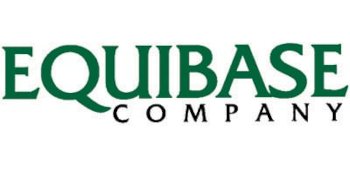
See current Equibase Stats for Slade Jones
Interesting Articles
- Jockey Antonio Gallardo on Facebook
- Jockey Antonio Gallardo on Instagram
- Jockey – Antonio Gallardo on Twitter
- August 13th, 2022 | Antonio Gallardo Makes Himself at Home at Woodbine | Chris Lomon for Woodbine Communications
- December 31st, 2021 | Gallardo Found Woodbine to his Liking, but Glad to be Home
- August 6th, 2021 | Newcomer Gallardo making impact on meet | By Ron Gierkink Daily Racing Form
- February 4th, 2021 | Ed DeRosa talks with Antonio Gallardo – YouTube | TwinSpires
- February 3, 2021 | Jockey Gallardo Celebrates His 2,000th Win | By BloodHorse Staff
- February 3, 2021 | Gallardo Celebrates 2,000th Winner At Tampa | by Mike Henry/Tampa Bay Downs
